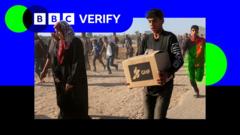What’s Inside the GHF Aid Box for Gaza?

Understanding the Humanitarian Crisis in Gaza: The Starvation Emergency
The situation in Gaza has reached a critical point, with more than two million Palestinians facing an escalating starvation crisis. The United Nations has reported a significant rise in deaths attributed to malnutrition, underscoring the urgency of the crisis. This article explores the humanitarian efforts being made, the nutritional adequacy of aid provided, and the broader implications of the ongoing conflict in the region. Understanding the complexities of this crisis is essential as it highlights the intersection of politics, humanitarianism, and health.
The Scope of the Crisis
The humanitarian crisis in Gaza is characterized by a severe lack of basic necessities, leading to alarming rates of malnutrition. According to the UN, the situation is dire, with thousands of vulnerable individuals, including women and children, at risk. The statistics are staggering: nearly one in three people in Gaza are going days without food. Such numbers illustrate the gravity of the situation and the urgent need for comprehensive humanitarian assistance.
The Role of the Gaza Humanitarian Foundation (GHF)
The Gaza Humanitarian Foundation (GHF) has been operating in the region since late May, aiming to alleviate the suffering of the local population. Funded by Israel and the United States, the GHF claims to have distributed 91 million meals primarily in the form of food boxes. However, the effectiveness and nutritional value of these food boxes have come under scrutiny. Independent verification of the contents has proven challenging due to restrictions on international journalists entering Gaza, raising concerns about transparency in the aid distribution process.
Examining the Nutritional Value of Aid
The contents of the food boxes provided by the GHF have been a subject of debate among experts. Videos circulated online by residents reveal that the boxes contain primarily dried food items, such as pasta, chickpeas, lentils, and wheat flour, requiring water and fuel for cooking. While these items provide caloric intake, experts warn that they lack essential nutrients.
Caloric Needs vs. Nutritional Quality
A typical food box from the GHF reportedly contains 42,500 calories, claiming to feed 5.5 people for 3.5 days. This caloric provision, while substantial, presents a fundamental issue: it addresses immediate hunger but does not account for long-term nutritional needs. Prof. Stuart Gordon from the London School of Economics highlighted that while the food basket may prevent acute hunger, it leads to "hidden hunger," which can result in serious health complications over time. The absence of vital nutrients can exacerbate health issues, particularly for children and pregnant women.
Deficiencies and Health Risks
Experts have pointed out critical deficiencies in the food provided by the GHF. Dr. Andrew Seal from University College London emphasized that the food boxes lack calcium, iron, zinc, and essential vitamins like C, D, B12, and K. Such deficiencies could lead to severe health problems, including anemia and scurvy. Furthermore, the absence of age-appropriate foods for young children raises additional concerns about the long-term health of the next generation in Gaza.
Comparison with Other Humanitarian Aid Models
Unlike the GHF, organizations like the World Food Programme (WFP) typically distribute food in bulk and supplement it with targeted nutrition for vulnerable groups. This approach ensures that the most at-risk populations receive the necessary nutrients to thrive. The WFP has also highlighted its commitment to delivering emergency supplies for young children and pregnant women, recognizing their unique nutritional needs during crises.
Challenges of Cooking and Food Preparation
Even for those who manage to receive a food box, the challenges do not end there. The residents of Gaza face a severe water crisis and a significant shortage of fuel, making it difficult to prepare the provided food items. The UN's Office of Humanitarian Affairs (OCHA) has warned that conditions are rapidly deteriorating, with families resorting to unsafe cooking methods, such as using waste materials. This situation exacerbates health risks and underscores the need for comprehensive solutions that address both food security and access to safe cooking resources.
The Black Market for Cooking Supplies
The ongoing conflict has led to a halt in official supplies of cooking gas, forcing families to turn to the black market for cooking fuel. Prices have skyrocketed, increasing up to 4,000% higher than pre-conflict levels, making it nearly impossible for many to afford the means to cook meals. This dynamic further complicates the already dire situation and highlights the urgent need for humanitarian intervention.
The Broader Implications of the Crisis
The humanitarian crisis in Gaza is not only a matter of food insecurity; it is a multifaceted issue that touches on political, social, and health dimensions. The increasing rates of malnutrition and the lack of access to essential supplies present significant challenges for the population, creating a cycle of poverty and health deterioration. UN Secretary-General António Guterres has noted that Gazans are facing grave shortages of basic supplies, with malnutrition rates soaring among women and children.
International Response and Support
The international community has a critical role to play in addressing the humanitarian crisis in Gaza. Humanitarian organizations must ensure that aid efforts are transparent, effective, and responsive to the needs of the population. Collaboration among various aid agencies can enhance the efficiency of the response and ensure that vulnerable groups receive the support they need. It is essential for international bodies to advocate for the rights and needs of the Gazan population in the face of ongoing challenges.
Future Steps Towards Improvement
Addressing the humanitarian crisis in Gaza requires a multi-dimensional approach. Key steps can include:
- Enhancing transparency in aid distribution to ensure that nutritional needs are met.
- Establishing safe and reliable channels for cooking fuel and water supply.
- Fostering international collaboration to improve the efficiency of humanitarian efforts.
- Implementing programs that address the specific dietary needs of vulnerable populations.
Conclusion: A Call for Comprehensive Action
The humanitarian crisis in Gaza is a pressing issue that requires immediate attention and action. As malnutrition rates continue to rise, it is crucial for the international community to come together to provide effective support and resources to those in need. The situation in Gaza serves as a stark reminder of the importance of addressing both immediate hunger and long-term nutritional needs. Only by fostering collaboration and ensuring transparency can we hope to alleviate the suffering of the Palestinian people.
FAQs
What are the main causes of the humanitarian crisis in Gaza?
The humanitarian crisis in Gaza is primarily caused by ongoing conflict, restrictions on movement, and blockades that limit access to essential supplies, including food, water, and medical care.
How does malnutrition affect children in Gaza?
Malnutrition can lead to severe health complications in children, including stunted growth, weakened immune systems, and increased susceptibility to diseases. It can also impact cognitive development and overall well-being.
What role do international organizations play in providing aid to Gaza?
International organizations play a crucial role in providing humanitarian aid to Gaza by distributing food, water, and medical supplies, advocating for the rights of the population, and addressing the specific needs of vulnerable groups.
What steps can be taken to improve the humanitarian situation in Gaza? Addressing the crisis requires a multi-faceted approach, including enhancing transparency in aid distribution, ensuring the availability of cooking supplies, and fostering international collaboration to meet the needs of the population. #GazaCrisis #HumanitarianAid #Nutrition
Published: 2025-07-26 00:00:41 | Category: technology



